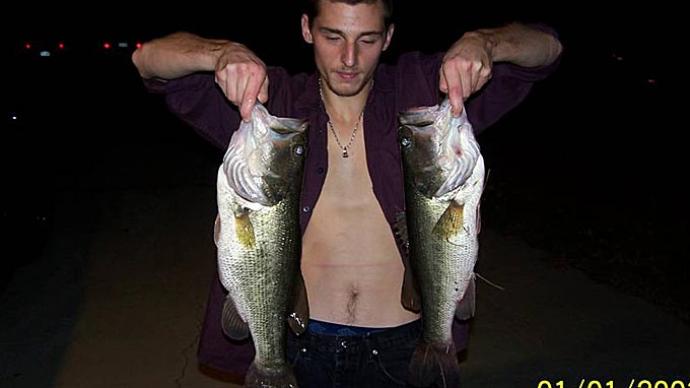
The old myth tends to portray the hot weather of summer as a death knell for good fishing. In reality there are several reasons that it could be argued that this time of year can be the most productive period. To begin with the warmer water cranks up the metabolism of bass and they are likely to be more aggressive than in colder water periods. If you will work out patterns, they tend to be more reproducible for days or weeks at a time.
To a large degree you first need to decide when you want to fish and plan a strategy around the highest likelihood of productivity based on that time of day. If you can't take the heat, then start with the next two options. These are either after dark or the late afternoon and early morning periods. If you can go without sleep then you immediately pick up an advantage in that you avoid most of the pleasure boat crowd. Most of those that are still out on the water pose some special problems in that they are often very inexperienced in navigating in the dark. In fact the closest I have come to an accident on the water was when a barge loaded with a looped crowd simply never saw our running lights and without our sudden retreat would have fused into our rig. On another occasion, a properly lighted sailboat quietly cut between two of our anchored boats.
The answer to the question as to how this happened was that the driver couldn't judge distance to us until already upon us. Nevertheless it can't be argued that the night crowd certainly have a cooler environment in which to fish and in some ways more options. Some bass move into the shallows at night, for foraging, while others simply concentrate along specific structure such as a point, roadbed, or a creek channel.
It is therefore not unusual to find some fisherman who swear by topwaters such as chuggers or buzzbaits and spend their time fishing shallower water areas at night especially favorite areas with vegetation. Bass can see against the background of the sky, but a little vibration or noise doesn't hurt to get extra attention. Folks often vary the size of the blade of their spinnerbait or the amount of noise made with the topwater until they determine the most productive approach for given conditions. There is a preferable common thread in that often the favorite color is a black, black and blue, or another dark color. One place where I have seen a light color such as white or chartreuse work is under bright lights around boathouses or marinas.
Another lure that works around brightly illuminated areas is a stick-swimming minnow bait such as chrome Rogue or Redfin.
If you aren't to keen on missing your sleep, but also don't like the heat, then you have a short but often active window of peak fishing period around daylight and dusk. The bass that you are after during these periods are often the same ones that the shallow-water night fishermen are after. Thus you can work these fish with the same baits. These are often scattered individual fish, but a small area may hold numerous, fish at a time. Some of the determinants as to the quality of a shallow-water area for holding fish either in the low-light periods or at night is the closeness of deep water and the availability of vegetation or some other structure. The key for early and late is to play the shadows.
It isn't by accident that a boathouse, which apparently doesn't hold bass during midday, suddenly begins to be productive when it casts longer shadows. Bass will chase food into the sun-drenched areas, but if given the choice will hold in either shade or drop back to deeper water where sun protection is provided.
The difference between fishing in the low light conditions of either late or early in the day versus fishing shallow water at night starts with us remembering that the fish have extremely better vision than we do in low light. So you may find that much better results may be obtained with smaller and quieter-worked topwaters or smaller bladed spinners than you would chose to use at night. This is often especially true in calm wind conditions.
If you chose to fish deeper patterns at night, then the hands down choice is to use a lizard or worm. If you really get serious about the night fishing in this manner then use a florescent line and black light to help you "see" line movement close to your perception during the daylight. The game plan for "deep night" fishing is to first know your area and be sure you can safely navigate to the spot and secondly look for typical holding patterns such as a creek channel close to a deeper channel. The end of points or humps, adjacent to steep drops, are also good choices. Black, black and blue, or brown colors in lizards, worms, or craw-worms are favorite choices. It is not a bad idea to try a Carolina rig as well as Texas rig to test if having the bait a distance off the bottom is preferable on a given night.
If you can handle the heat then the daytime fishing is often very productive. One of the things you can eliminate is any shallow-water area without vegetation. By contrast, shallow-water areas with thick vegetation can hold fish even during the midday periods. These fish will be on the bottom and to get to them you are going to have to either crash the green stuff with a heavy weighed and pegged worm or lizard or better yet with a jig on which you have a craw-worm trailer. If the growth is not thick enough to offer shade then forget it.
The easy fish to work are those that are feeding on shad and bunched in schools. If these bass are breaking then you have an easy time of planning how to work them. More often than not I have found schooling activity not due to seeing breaking fish, but by working an area and hitting several fish. Actually I prefer these types of packs because anyone can see the breaking schools. In either case the fish will tend to be in the same area for days or possibly for the entire summer. Such schooling areas often have a rhyme and reason if you look for it. There is usually a rise, drop, or an underwater structure that holds shad or about which the shad migrate. It also usually has a good holding place close by from where the bass can attack and retreat after feeding as a pack.
These places often can vary on a given lake based on the water clarity from site to site. The usual rule of thumb is that the clearer the water, the deeper bass hold during the day. The opposite is also true in a lake with considerable density like Livingston or Cooper. Bass in these stained water lakes will often be in bunches found in less than 10 feet, even during the heat of day.
If these schooling fish are feeding on shad, then a chrome- or gray- colored crankbait is a good starting place. If they are actually breaking the surface of the water, then working a Zara Spook in a silver color is a good "attention getter." If the school is breaking in thick vegetation or in brush then consider using a white or yellow buzzbait. These not only will get strikes, but they will go through places where a plug with treble hooks has a problem.
Once you have located a school with a crank, try to get them interested in a worm. In some instances they are set on a shad-like bait and aren't interested in anything else. But if you can get them on a soft plastic, you can often work the school longer than if you try to milk the school with cranks. To some degree I have always believed the determinant of how a school reacts to one of their friends being taken away by a shad with hooks is related to how skittish the school is programmed to respond. I have seen some that will continue to school as boats run through their activity areas whereas others panic at the sound of a large noise from the boat or at the first fish that is lost close to the school.
The main thing you have to do to enjoy fishing during warm-weather months is to pick the period of the day that suits your preference and then plan a strategy that is most likely to succeed during that period.




